|
After
forty years of firing handguns I sometimes wonder when common
sense will prevail. Small bores such as the .38 and 9mm will not
do the work of the .45 no matter how we try to compel them to do
so. But there are small bores and then there is the .38 Super
and the .357 Magnum. The .357 Magnum revolver cartridge has
earned a great reputation in police work not only in America but
in France and Germany as well. Anti terror units in France
deploy the Magnum for use against vehicles and even in precision
optical sighted revolvers. While we are not happy with the
previous regime in France, any nation that produces an elite unit
capable of dealing with terrorists in the manner of the French
must be respected. On one occasion in France, six special
officers stormed a plane filled with hostages. Five of the first
six officers on board the plane were shot and knocked down but
not killed while the last officer began to take out the
terrorists. In short, 1,100 rounds were fired and a half dozen
terrorists killed without the loss of life of a single hostage.
The French have the cran if only their leaders could supply the
élan!
Back
to the .357 SIG - let me make a point before we go any further - none
of the other small bores approach the real power of the Magnum.
Sure, gun writers in the popular press have done cute tricks
such as comparing a three inch barrel Magnum with mid range
loads to a 9mm Luger with +P+ loads and five inch barrel and
declaring the 9mm a pocket Magnum. In the real world, in service
grade handguns, the .357 Magnum outstrips not only the 9mm but
the .357 SIG and .38 Super as well. The automatic pistol is
easier to use well in a personal defense situation, however. The
reciprocating action of the automatic soaks up a portion of
recoil and the relatively fast burning cartridges used in the
smaller capacity automatic pistol cartridge generates less
recoil energy. The Magnum is harder to handle but for
generations cops regarded the Magnum as a real problem solver.
Producing
Magnum ballistics in an automatic pistol is a desirable thing.
High velocity, penetration, and wound effect are desirable in a
service pistol in view of the percentage of felons encountered
in vehicles and behind light cover. There are situations in
which greater penetration than the .45 auto may deliver is
warranted. As an example, I
have in my files a case in which Texas officers at a roadblock
hit a 1930s style vehicle seventeen times with the .45 auto
(from a Thompson submachinegun) but failed to neutralize the
criminal gang in the vehicle. This was one reason for the .38 Super
pistol's popularity.
The
.357 Magnum has produced results on motivated felons similar to
high power rifle hits. I observed a felon who had been struck by
a .357 Magnum 125 grain JHP.
The felon had been running and firing over his shoulder
at the officer. The officer had returned fire at fifteen yards,
on the run. The bullet had struck the point of the jaw where it
meets the skull. The offender’s eyeballs were blown out by
hydrostatic pressure and the top row of teeth taken out by the
exiting bullet. On another occasion I chased a large angry
mongrel that had bitten the end of a citizens finger off. I
fired a single 125 grain JHP at about ten yards. The effect was
immediate: the chest wall where the bullet impacted actually
caved in and on the opposite side, blood and lung tissue were
strewn for six feet or more. There have been any number of
failures to quickly drop felons or to euthanize dangerous
animals with small bore cartridges. I am aware of another case
in which an officer fired fourteen rounds of 147 grain 9mm into
the back of a pit bull that had clomped onto a child and refused
to let go. The dog sagged to the ground as the Glock slide
locked back on the last round. In fairness, even the .45
doesn’t always do the job with one round. On
another occasion in dealing with dangerous animals, I was charged
by a drug dealer's guard dog. My .45 spoke twice before the job
was done. The second did the job, and none too soon.
One
of the attempts to equal the .357 Magnum in an automatic pistol
is the .357 SIG. There are hurdles, but the necked down .40 S
& W round seems to have made the hurdle. A problem with
automatic pistol cartridges is the bullet design. Revolvers may
use bullets with plenty of exposed lead on the tip, resulting in
good expansion. The automatic must use a bullet with a rolled
over ogive. This ensures feed reliability. The .357 SIG is a
bottlenecked round that offers excellent feed reliability.
Intelligent bullet design is a key. For the most part 357 SIG
rounds do not expand as aggressively as the .357 Magnum. They
seem more designed to penetrate deeply on light cover.
The .357 SIG is simply a .40 caliber Smith and Wesson necked
down to 9mm. I think that 9mm SIG would have went over like a
lead Zeppelin so the .357 SIG moniker was chosen, obviously to
play upon the legendary .357 Magnum. My first experience with
the .357 SIG was very positive. At the time I owned a Glock M 22
in .40 Smith and Wesson. The pistol was reliable but nothing to
brag about in terms of accuracy. I added Novak sights and
replaced the cheap plastic Glock sights and enjoyed better
practical accuracy. But the best the pistol did was a three and
one half inch group at 25 yards with Winchester 180 grain JHP.
When the .357 SIG was introduced I had an assignment to do an in
depth review. I ordered a Bar Sto Precision barrel for the Glock
in .357 SIg. That is all that is required to convert between
calibers, a new barrel. Bar Sto is a precision match grade
barrel but just the same I was surprised by the accuracy
potential. On
occasion I fired a 75 foot five shot group of 1.25 inches with
the then new 125 grain Cor Bon loading. This experience has
followed true, with the .357 SIG usually proving out more
accurate than the .40 in quality pistols. This is even true of
the SIG P 229 although the P 229 is very accurate in either
caliber. another advantage of the .357 SIG is that it is a short
case cartridge. It may be chambered in basic 9mm/40 size
pistols. The .38 Super and 10mm require .45 frame pistols.
Does
the .357 SIG equal the .357 Magnum? Yes and no. The bullets used
in the .357 SIG do not expand and fragment as dynamically as the
.357 Magnum. In personal defense, the 115 to 124 grain .357 SIG
bullets are fine but as we move to the 140 grain weight the .357
Magnum's greater case capacity shows much greater power. In the
real world, the .357 SIG has as much punch with comparable 125
gain loads as the .357 Magnum. the long suit of the .357 SIG is
penetration. As an example, a few years ago I conducted a major
test of the popular handgun service cartridges against vehicles.
I used actual vehicles and some sheet metal, and included
windshields and door glass. The single most effective loading
proved to be the Hornady 124 grain XTP in .357 SIG caliber. It
was not the fastest but it was among the most accurate and
clearly the single cartridge with the greatest penetration. On
the basic premise of the cartridge, penetration, the .357 SIG
meets its design specifications. As for effect on flesh and
blood targets, I have seen mixed results. While overall more
effective than the 9mm +P, I have used the .357 SIG on small
game and pests and found the cartridge not as instantly
effective as the .357 Magnum. A cartridge that does not reliable
anchor a 35 pound animal may prove distressing in police work.
An exception has been the 115 grain Cor Bon. This load uses a
bullet that expands and fragments dynamically at the expense of
penetration. The verdict?
Penetration
and reliability are there. Accuracy is excellent, and the
cartridge shoots flat. If you deploy the .357 SIG, the Cor Bon
line deserves a hard look. The 115 grain load exits my Glock at
well over 1500 fps and a bit less from the SIG. This is a load
that expands and fragments and definitely has potential. The 125
grain JHP is a little slower, fragments a little less, and has a
bit more penetration. It may just be the ideal compromise load
with very little in the way of compromise. For police service
the new DPX load bears some discussion. This is a 125 grain DPX
(Barnes) bullet at 1300 fps. There is little point in driving
this bullet faster, and with its long for the caliber profile
case capacity does not allow greater velocity. But the DPX load
produces unfailing good results on light cover and in gelatin
testing. I am continually impressed by the balance of
penetration and expansion and excellent accuracy demonstrated by
the Cor Bon DPX line. This is simply a great loading.
Overall,
I find the .357 SIG an interesting
loading. While I am fond of the .38 Super the .357 SIG does much
the same thing in a lighter platform and with absolute
reliability. Accuracy is good, and the SIG P 229 is a wonderful
all around handgun. I think that you will find the .357 SIG a
cartridge of interest.
R.K.
Campbell
  
Got something to say about this article? Want to agree (or
disagree) with it? Click the following link to go to the GUNBlast Feedback Page.
|
|
Click pictures for a larger version.
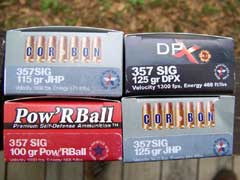
There
are a greater variety of loads available for the .357 SIG than
ever before, enough to fill most needs.
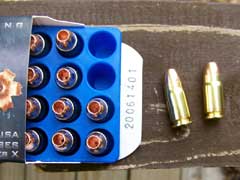
The
author is not easily impressed, but the DPX load from
Cor Bon is among the most impressive additions to the line in
some time.
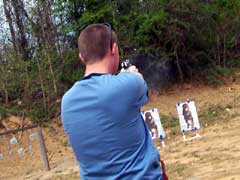
Control
means a lot. Here, the author's young friend takes on Law
Enforcement Incorporated targets with this 9mm --- the
.357 SIG will give a greater measure of confidence.
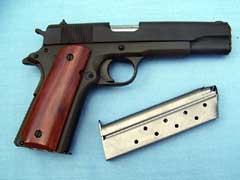
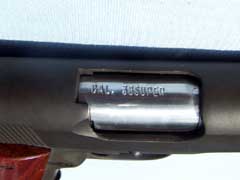
The
author's favorite .38 Super is certainly viable, but a 30
ounce .357 SIG has much to recommend.
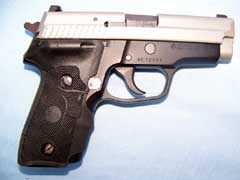
This
is the author’s Crimson Trace equipped SIG P 229,
originally a .40 now with a spare barrel in .357 SIG. This is
a sweet, sweet shooting piece.
|
![]()